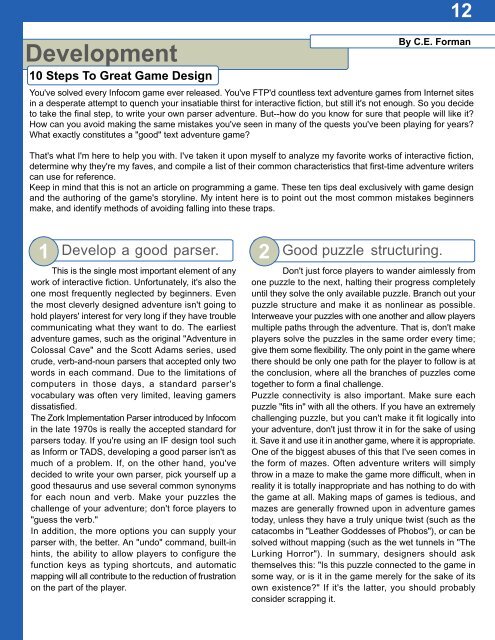You also want an ePaper? Increase the reach of your titles
YUMPU automatically turns print PDFs into web optimized ePapers that Google loves.
Development<br />
10 Steps To Great Game Design<br />
12<br />
By C.E. Forman<br />
You've solved every Infocom game ever released. You've FTP'd countless text adventure games from Internet sites<br />
in a desperate attempt to quench your insatiable thirst for interactive fiction, but still it's not enough. So you decide<br />
to take the final step, to write your own parser adventure. But--how do you know for sure that people will like it?<br />
How can you avoid making the same mistakes you've seen in many of the quests you've been playing for years?<br />
What exactly constitutes a "good" text adventure game?<br />
That's what I'm here to help you with. I've taken it upon myself to analyze my favorite works of interactive fiction,<br />
determine why they're my faves, and compile a list of their common characteristics that first-time adventure writers<br />
can use for reference.<br />
Keep in mind that this is not an article on programming a game. These ten tips deal exclusively with game design<br />
and the authoring of the game's storyline. My intent here is to point out the most common mistakes beginners<br />
make, and identify methods of avoiding falling into these traps.<br />
1<br />
Develop a good parser.<br />
This is the single most important element of any<br />
work of interactive fiction. Unfortunately, it's also the<br />
one most frequently neglected by beginners. Even<br />
the most cleverly designed adventure isn't going to<br />
hold players' interest for very long if they have trouble<br />
communicating what they want to do. The earliest<br />
adventure games, such as the original "Adventure in<br />
Colossal Cave" and the Scott Adams series, used<br />
crude, verb-and-noun parsers that accepted only two<br />
words in each command. Due to the limitations of<br />
computers in those days, a standard parser's<br />
vocabulary was often very limited, leaving gamers<br />
dissatisfied.<br />
The Zork Implementation Parser introduced by Infocom<br />
in the late 1970s is really the accepted standard for<br />
parsers today. If you're using an IF design tool such<br />
as Inform or TADS, developing a good parser isn't as<br />
much of a problem. If, on the other hand, you've<br />
decided to write your own parser, pick yourself up a<br />
good thesaurus and use several common synonyms<br />
for each noun and verb. Make your puzzles the<br />
challenge of your adventure; don't force players to<br />
"guess the verb."<br />
In addition, the more options you can supply your<br />
parser with, the better. An "undo" command, built-in<br />
hints, the ability to allow players to configure the<br />
function keys as typing shortcuts, and automatic<br />
mapping will all contribute to the reduction of frustration<br />
on the part of the player.<br />
2<br />
Good puzzle structuring.<br />
Don't just force players to wander aimlessly from<br />
one puzzle to the next, halting their progress completely<br />
until they solve the only available puzzle. Branch out your<br />
puzzle structure and make it as nonlinear as possible.<br />
Interweave your puzzles with one another and allow players<br />
multiple paths through the adventure. That is, don't make<br />
players solve the puzzles in the same order every time;<br />
give them some flexibility. The only point in the game where<br />
there should be only one path for the player to follow is at<br />
the conclusion, where all the branches of puzzles come<br />
together to form a final challenge.<br />
Puzzle connectivity is also important. Make sure each<br />
puzzle "fits in" with all the others. If you have an extremely<br />
challenging puzzle, but you can't make it fit logically into<br />
your adventure, don't just throw it in for the sake of using<br />
it. Save it and use it in another game, where it is appropriate.<br />
One of the biggest abuses of this that I've seen comes in<br />
the form of mazes. Often adventure writers will simply<br />
throw in a maze to make the game more difficult, when in<br />
reality it is totally inappropriate and has nothing to do with<br />
the game at all. Making maps of games is tedious, and<br />
mazes are generally frowned upon in adventure games<br />
today, unless they have a truly unique twist (such as the<br />
catacombs in "Leather Goddesses of Phobos"), or can be<br />
solved without mapping (such as the wet tunnels in "The<br />
Lurking Horror"). In summary, designers should ask<br />
themselves this: "Is this puzzle connected to the game in<br />
some way, or is it in the game merely for the sake of its<br />
own existence?" If it's the latter, you should probably<br />
consider scrapping it.


